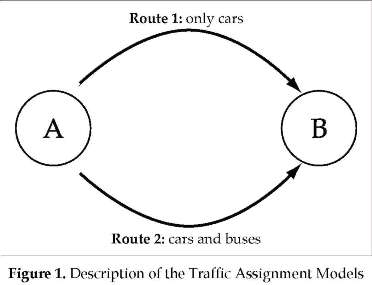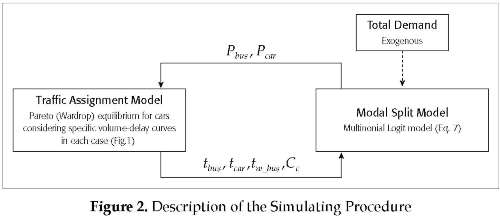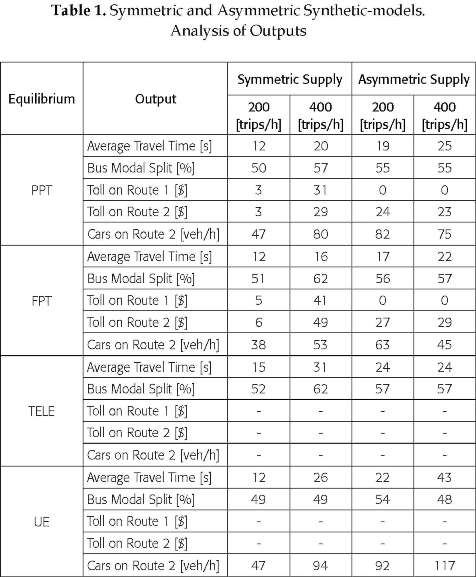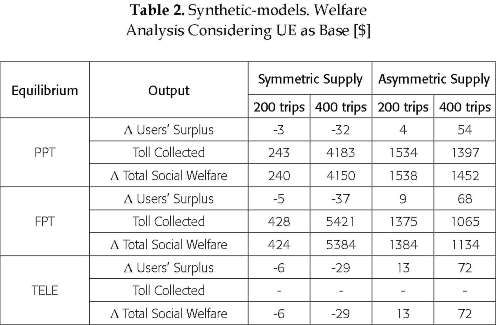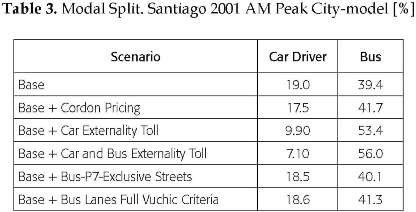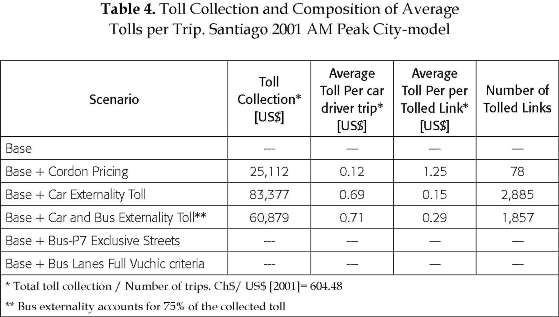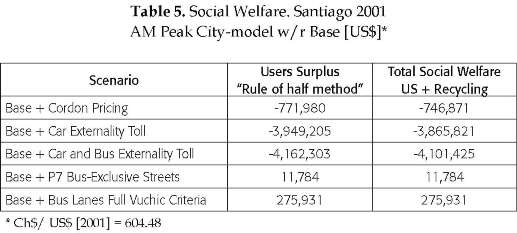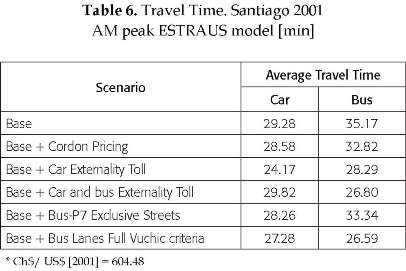Services on Demand
Journal
Article
Indicators
-
 Cited by SciELO
Cited by SciELO -
 Access statistics
Access statistics
Related links
-
 Cited by Google
Cited by Google -
 Similars in
SciELO
Similars in
SciELO -
 Similars in Google
Similars in Google
Share
Ingeniería y Desarrollo
Print version ISSN 0122-3461On-line version ISSN 2145-9371
Ing. Desarro. vol.29 no.1 Barranquilla Jan./June 2011
ARTÍCULO DE INVESTIGACIÓN / RESEARCH ARTICLE
Urban transportation system optimum: The effect of accounting for the interaction of buses and cars
Óptimo de sistema en transporte urbano: el efecto de incorporar la interacción entre buses y autos
Cristian Angelo Guevara* Enrique Valdés** Javiera Dávila***
Facultad de Ingeniería y Ciencias Aplicadas, Universidad de los Andes, Chile
Corresponding Author: San Carlos de Apoquindo, 2200, Las Condes, Santiago, Chile. Tel: 56-2-412-9364 Fax: 56-2-412-9642
Grants and support: This research was funded by "Fondo de Ayuda a la Investigación" from the Universidad de los Andes, Santiago Chile; project FAI ICIV-001-08.
Fecha de recepción: 22 de octubre de 2010
Fecha de aceptación: 2 de mayo de 2010
Abstract
We use an iterative methodology to calculate Pigouvian tolls when the street is shared by cars and buses. We compare scenarios where: 1) the toll is calculated, conventionally, considering only the externality over other vehicles; 2) the toll is calculated considering the impact over other vehicles' passengers; 3) no tolls are applied; 4) no tolls are applied, but some lanes or streets are reserved for buses. The methodology is applied first to a synthetic-model that considers homogeneity of demand and some level of heterogeneity of supply. Then, the methodology is extended to a city-model, a simultaneous four-stage model calibrated with real data from Santiago, Chile. Results show that when the externality over passengers is considered, car tolls in roads of mixed-use are significantly higher than conventionally estimated and, consequently, car flows shrink on those roads. Simulation results also show that the outcome of the reservation of capacity for buses depends on a careful design of this policy and could range from a social detriment, to be significantly superior to Pigouvian pricing. Experiments also show that, ifbus' paths are fixed, tolls calculated considering the externality over vehicle's users may result in a social detriment. Finally, all Pigouvian pricing scenarios in the city-model resulted in a reduction in social welfare. This remarkable result can be attributed to: 1) the fact that the city-model tends to simile general equilibrium, whereas Pigouvian tolls are calculated from a partial equilibrium perspective; 2) limitations of the city-model or a manifestation of Coase's counterexample for Pigouvian taxation, resulting from the fact that agent's opportunity cost is heterogeneous. We finish discussing the impact of these findings in policy analysis.
Keywords: congestion pricing; Pigouvian taxes; public transportation; bus lanes; bus streets.
Resumen
En este trabajo se usa un método iterativo para calcular tarifas Pigouvianas cuando las vías son compartidas por autos y buses. Se comparan escenarios en los cuales: 1) la tarifa es calculada considerando sólo la externalidad sobre otros vehículos; 2) la tarifa considera además la externalidad sobre los pasajeros de los vehículos; 3) no se aplican tarifas; y 4) no se aplican tarifas, pero algunas pistas son reservadas para el uso exclusivo de buses. El método es aplicado primero a un modelo idealizado que considera homogenidad de la demanda y cierto grado de heterogenidad en la oferta. Luego el método es aplicado en un experimento con datos reales basado en un modelo simultáneo de cuatro etapas calibrado para la ciudad de Santiago, Chile. Todos los experimentos muestran que cuando se considera la externalidad sobre los pasajeros de los vehículos, las tarifas Pigouvianas crecen sustancialmente en las vías de uso mixto, lo cual se traduce en un menor flujo de automóviles en dichas vías. Por otro lado, las simulaciones con el modelo idealizado muestran que el efecto de la reservación de pistas depende fuertemente del diseño considerado. Respecto de la tarificación Pigouviana, el experimento con datos reales muestra, sorprendentemente, que dicha política resultaría ser inferior a un escenario en el cual no se aplican tarifas. Este resultado podría atribuirse a: 1) que el modelo con datos reales representa una situación de equilibrio general y en cambio las tarifas Pigouvianas se calculan usando un enfoque de equilibrio parcial; 2) limitaciones de modelación en el experimento con datos reales; o 3) una manifestación del contraejemplo de Coase para los impuestos Pigouvianos. El artículo termina discutiendo el impacto de estos resultados en el análisis de políticas de transporte urbano.
Palabras clave: tarificación por congestión; impuestos Pigouvianos; transporte público; carriles solo bus; calles solo bus.
1. INTRODUCTION
Optimal allocation of limited resources is a fundamental problem of society. When the cost perceived by the agents (private cost) differs from the cost caused by the agent to the whole society (marginal social cost), this allocation is not optimal. The difference between social and private cost is known as externality or external cost. Pigou [1] was the first to propose, correcting this distortion by applying a tax equivalent to the difference between social and private cost at equilibrium demand levels. These taxes were known afterwards on his behalf as Pigouvian taxes.
Since the twenties, Pigouvian taxation theory quickly spread over many knowledge fields, eventually reaching the transportation area [2] . The conventional way to determine Pigouvian taxes in transportation systems starts assuming that the value of time is equal across the population; that only cars make up the system; that each person drives alone; and that only travel time matters, ignoring noise, pollution, visual intrusion, accidents, delays caused by cars to other road users like buses, trucks and pedestrians. Under those assumptions Piguovian taxes will correspond to expression (1) where tmg_soc and tprivcorrespond to marginal social and private travel times respectively.

Marginal social time can be calculated as in expression (2) where two components can be distinguished. The first corresponds to the time perceived by the driver and the other corresponds to the extra time his or her marginal trip causes over all the drivers. Since private time is subtracted from marginal social time in (1), only the second term in (2) remains in the calculation of the Pigouvian toll.

This research is primarily motivated in studying the effect of relaxing one of the assumptions described above. The main hypothesis is that, in the presence of buses on mixed-use roads, when marginal social costs are considered at the level of people instead of vehicles, optimal tolls would become considerably higher than usually estimated, making them, as a consequence, almost uncollectible [3] . Accordingly, the second hypothesis is that a reserved bus-lanes or bus-streets policy would become a potential surrogate or complement for optimal congestion pricing.
Mohring [4] , Viton [5] and Small [6] are some of a few examples where this research question has been partially studied by means of synthetic microeconomic models. Our research extends their theoretical approach by considering a synthetic-model that includes a substitute route and then by performing a simulation with a city-model considering heterogeneity in supply and demand, based in four-stage simulating model ESTRAUS [7] , calibrated with real data from the city of Santiago de Chile.
The structure of the article continues as follows. In section 2 the theoretical formulation of the marginal social cost curves in an aggregated-static framework is analyzed, considering explicitly the impact on bus and car users. In section 3 two variations of a synthetic-model are simulated, under the theoretical framework considered in the previous section. In section 4 is presented the application and analysis of this framework to the city-model calibrated with real data is reported. In the final section, main results are summarized and their potential broader consequences are analyzed.
2. EXTERNALITIES CONSIDERING PEOPLE INSTEAD OF VEHICLES IN MIXED-USE STREETS.
Consider the case where buses and cars share the road. We will concentrate on the analytic derivation of Pigouvian taxes under this scenario, which remains a simple task thanks to other simplifying assumptions are still considered.
In the case of car externalities, marginal social cost of an additional trip by car should account not only for car riders, but also for bus passengers as well. This is shown in expression (3), where pbcorresponds to the number of bus passengers riding on this street, λ is a scalar that accounts for the additional travel time of a bus compared to a car and η corresponds to average car occupancy.

Under this framework, private travel time of each car rider will correspond to the first term in brackets in expression (3). Externality in this case has two components, one corresponds to the externality over other car users, and the second represents the externality caused to bus users. For streets with a significant amount of people traveling by bus, this last term, usually neglected in traditional calculation of Pigouvian tolls, would become substantially big, rapidly surpassing the size of the second term.
This implies that Pigouvian car tolls for mixed-use roads should be substantially higher than usually estimated. This argument supports the hypotheses suggested in section one. On one hand, higher car tolls will imply an additional burden on the already low public popularity in regards to congestion pricing. Qn the other hand, higher car tolls would imply a reduced number of cars on the roads of mixed-use, a result that could, to some extent, be replicated by means of the reservation of lanes for the exclusive use of buses.
The externalities caused by bus riders remains to be analyzed. If it is assumed, for simplicity, that bus frequencies are continuously adjusted to carry each additional passenger, bus riders' marginal social cost could be derived as in (4), where K corresponds to bus capacity, y corresponds to the car equivalence of each bus in term of the use of road space and X corresponds to the additional travel time experienced by bus riders, compared to car drivers in the same road.

It can be immediately noted that bus riders externality is multiplied by the factor ηγ/K times the car Pigouvian tax. In general, this factor will be around 1/20th. Thus, for the rest of the analysis in this article this externality can be safely neglected.
3. SIMULATION OF TWO SYNTHETIC-MODELS
In this section a synthetic-model of modal split and traffic assignment is developed. The model corresponds to an extension of the model considered in [8] . It is very simplistic in order to allow a clean analysis of the dynamic effect of the inclusion of the externality over bus riders in the calculation of Pigouvian tolls as demand and supply varies.
3.1 Models Description
Two assignment models were considered: a Symmetrical Model and an Asymmetrical model. Both consider a single origin-destination pair (A -B) and two routes. une of such routes (Route 1) considers exclusively cars and the other (Route 2) considers mixed traffic of buses and cars as shown in Figure 1.
Volume-delay curves of each route are of bureau of Public Roads (BPR) type [9] . For the Symmetrical model both volume delay functions are equal to (5), where fbicorresponds to bus frequency, which is zero for route 1 since buses are not allowed on it. This model could represent the Center Business District of a city in which supply and demand is evenly distributed and only some streets are devoted to the use of buses.

In the case of the Asymmetrical model, the BPR function for route 2 is equal to (5), but for route 1 it is equal to (6). The idea of this second exercise is to resemble cases where longer routes with plenty of capacity are available, which would be the case, for example, of a whole city analysis.

To estimate the modal split between bus and car, it was considered that each decision-maker maximizes his or her indirect utility, conditional on the chosen mode. In turn, this utility function has a deterministic and a random component. The random component is assumed to be distributed extreme value (0,µ=1) which allows the percentage (or probability) of users choosing each mode (Pbusand Par) to be estimated by a multinomial logit model (see e.g. [9] ). In turn, the deterministic component of the utility is considered to depend linearly only upon mode travel time (tmode), bus waiting time (tw_mode) and, in the case of cars, upon the toll (ccar). The utility coefficient of travel time is assumed to be equal to minus Subjective Value of Travel Time Savings (SVTTS) (=0.01), and the coefficient of waiting time is assumed to be four times the one of travel time. Note that this configuration of modal utilities implies that they are in the same units as car cost and willingness to pay. Note also that willingness to pay for traveling is not considered, since it cancels out for each person's discrete choice process. Under this framework, modal split model can be summarized as shown in expression (7). Note that, for simplicity, bus fares and non-toll car costs were not considered in the analysis.

As shown in Figure 2, for a given level of total exogenous demand, equilibrium is attained iteratively when the level of service of the modal split and of traffic assignment models are consistent. Convergence criteria considered flow differences below 1E-08. The flow of buses is not optimized but instead determined as the flow required to exactly carry pbpassengers considering a vehicle capacity of K=40 people. Waiting time is calculated as half of bus headway (assuming uniform arrivals) and the impact of buses on the volume-delay curves is calculated as the flow of buses multiplied by a car-equivalency factor of γ=2.5. Finally there were considered coefficients of λ=1.15 for the extra travel time for buses and of η= 1.25 for the average number of persons by car.
The set of coefficients considered for the model was built following standards usually observed in practice. Other sets of coefficients were tested without significantly modifying either the analysis or the conclusions of this research. As stated before, the objective of this stage of the research is to study the dynamics of the system upon changes in exogenous total demand. The corroboration of the conclusions derived at this stage will be checked and complemented with the simulating model based on real data considered in the next section.
Under this framework the following four simulation experiments were developed, considering in each case exogenous levels of total demand of 200 and 400 total trips.
i. Users' Equilibrium (UE): Equilibrium that is reached spontaneously without any intervention on the system. It is the result of the fact that each individual maximizes his or her own utility independently. In our framework, it corresponds to considering Pareto or Wardrop [9] equilibrium conditions with the volume-delay curves shown in (5) and (6).
ii. Partial Pigouvian Tolls (PPT): Corresponds to the conventional way to determine Pigouvian tolls where only externalities over car users are considered. In our framework, it corresponds to considering Wardrop equilibrium with volume-delay curves that include the externality caused over car users, that is, the first and second component of expression (3), divided by η.
iii. Full Pigouvian Tolls (FPT): Corresponds to the alterative way to determine Pigouvian tolls, including not only externalities over car users, but also over bus passengers. In our framework, it corresponds to considering Wardrop equilibrium conditions with volume-delay curves that include all the three components of expression (3), divided by t . For simplicity, externality caused by bus passengers (4) was not considered in this equilibrium.
iv. Transit Exclusive Link Equilibrium (TELE): Corresponds to a UE where cars are not allowed to use the mixed-use route (Route 2).
3.2 Analysis of simulations results
Table 1 shows the principal results of simulated situations. In terms of the main hypothesis suggested in section one; results confirm that Pigouvian tolls become considerably higher than usually estimated when the externality over bus riders is considered. FPT tolls in the mixed-use route range between 13% and 100% higher than equivalent PPT tolls, depending on the model and levels of demand considered. In the case of the Symmetric model, this effect is also extended to the alternative route (route 1) because of the car migration from the mixed-use route that is highly tolled in the FPT case. FPT tolls in car-only routes range between 32% and 67% higher than equivalent PPT tolls. In the case of Asymmetric model, tolls remain null in route 1, since the capacity available allows serving the demand with free flow travel times.
In terms of the second hypothesis stated in section one; results do not fully confirm that devoting all the capacity of the mixed-use route for the use of cars would work as a surrogate for Pigouvian congestion pricing. Although TELE resembles almost identically the modal split attained with FPT, average travel times are considerably worse for TELE, and even worse than UE for the Symmetric model. Although it can be argued that, hidden in this average, bus riders' travel time is indeed always smaller in TELE than in FPT or UE, it would be inappropriate to propose a public policy which might decrease social wellbeing by increasing people's travel time.
Additionally, in terms of car flow on mixed-use route, the FPT case is far from being zero, which is indeed the more remarkable difference between this equilibrium and TELE. Despite this flow decreases with demand and, for higher levels, the numbers between FPT and TELE approach each other, the validity of the BPR curves over 400 [trips/h] is questionable.
These results motivated the simulation of an additional experiment where only half of mixed-use routes were exclusively devoted to buses for the Symmetric model and for a demand of 400 [trips/h] . This experiment, resulted in a reduction of bus modal split (55%) compared to TELE but, notably, it also attained an important reduction in average travel time down to 21 [s] . Although this average travel time is not as good as the one attained with FPT, it is better than UE and almost equal to PPT and, remarkably, the bus riders' travel time in this case is 20% lower than in FPT. This result could be interpreted as that only a detailed implementation of bus priority measures would ensure the achievement of public policy objectives partially similar to the social equilibrium that could be attained through Pigouvian congestion pricing.
Now, to complete the analysis of the hypothesis under study, Table 2 summarizes the social welfare analysis of the modeled experiments. For each case are shown the total user's surplus, the toll collected and the total social welfare.
Since in this experiment logit demand functions were considered and utilities were considered in money units, user's surplus could be calculated as the summation of each person's willingness to pay (WP) and their expected maximum utility EMU (see e.g. [10] ). Total social welfare will correspond to the sum of users' surplus and the toll collected. This is shown in expression (8) were µcorresponds to the scale factor of the extreme value distribution considered for the derivation of the logit model, ζcorresponds to the Euler constant (~0.577) and D corresponds to the total demand considered for each scenario. The scale factor µis not identifiable and will thus be set equal to one as usual.

However, note that modal utilities in (7) correspond to conditional-indirect-truncated utility functions. This implies that no information is available on actual willingness to pay for traveling and thus, only differences between scenarios are meaningful. This also allows the term ζ/µ to be safely ignored. Table 2 presents the results considering UE as the base case.
Consider the Symmetric model first. It can be immediately noted that, as asserted by Hau [11, 12] , the user's surplus under congestion pricing can be negative. This means that both car and bus users are worse with congestion pricing with FPT and PPT. For example for 400 [trips/h] , although the average travel time for FPT is 40% shorter than for UE, users also have to face a toll which more than compensates the reduction in travel time. This makes clear the reason for the unpopularity of congestion pricing and serves as one of the pillars for the hypothesis about the potential convenience of reserving capacity for buses.
Only after collected toll is considered as a society gain, does total social welfare become positive. It has to be recalled however that this implies that collecting the tolls is costless, which is very far from true. In the case of London, 43% of collected tolls are used to run the congestion pricing system [13] . Also regarding total social welfare, according to what would be expected; this number is greater for FPT than for PPT, since marginal social cost FPT considers the full externality effect in the calculation of the tolls.
In terms of unpopularity, if collected tolls can be somehow directly returned to drivers as a lump-sum, they will actually perceive the benefits of congestion pricing. However, it is not clear how this returned money could not change drivers' behavior back to the situation previous to the toll. Moreover, even if that innocuous lump-sum re-assignment would be possible, the net effect of such action on other markets is not clear. For example, Parry and Bento [14] showed that, if the labor market were not optimally taxed, congestion pricing and lump-sum returns to drivers would imply a net social negative benefit.
The case of TELE is again disappointing at first sight. Consistent with the increase in average travel time showed in Table 2, users' surplus and total social welfare is worse for TELE than for UE. However, in the case of the additional experiment considering that only half of the capacity of the mixed-use route is devoted to the exclusive use of buses, social welfare gain also turn to be positive compared to the UE case (+21 for the 400 [trips/h] case).
Summarizing up to this point, although congestion pricing shows the major social welfare results, it is remarkable that these benefits come only from collected tolls and that transportation system users will directly perceive a negative effect of congestion pricing. On the other hand, if a detailed implementation of bus priority measures are considered, not only a net positive social welfare could be attained, but also a positive users' perception of it.
Consider now the Asymmetric model. Remarkably, some of the results justified above for the Symmetrical model are no longer valid. Note first that for TELE, users' surplus is larger than for UE. This occurs because, in this case, route 1 has enough capacity to accommodate the cars traveling through at almost free flow time and thus with null tolls. The case where only half of the capacity is devoted to buses, as expected, has even larger benefits.
Users' surplus for PPT and FPT are also positive. This arguably occurs for the same reason exposed for TELE. In this case, drivers have an un-tolled and un-congested alternative and thus the effect of marginal pricing is a win-win situation. This is precisely the very famous seminal "narrow and wide roads" example used by Pigou [1] to illustrate the convenience of governmental intervention through road pricing to reduce congestion.
At first sight, it is an intriguing result that, for FPT, social welfare is smaller than for PPT. Since in FPT externalities are fully accounted for, it would be reasonable to expect better results for it. One possibility for explaining this result would be that the bus riders' externality (4) was not considered in the model. However, an additional model considering this effect was developed without attaining significant changes.
Another possible explanation comes from an interpretation of the reciprocal nature of the externalities, as explained by Coase [15] . The implementation of the FPT pricing produces an "extenality" over the toll collection agency by reducing the amount of drivers paying the toll and, it turns out that, for this example, the loss of tolled drivers is larger than the valuation of their savings in travel time because of the implementation of the toll.
An alternative possibility is that Pigouvian taxes do not work correctly because bus paths are not optimized in anyway. In this specific experiment, it would maybe be of benefit to have some of the buses riding in the route with high capacity and virtually no marginal effects. A model of such characteristics was performed for the 400 [trips/h] . This model attained a total social welfare which, compared to UE of $1509, is better than the one obtained with PPT, this confirms the conjecture.
This finding raises important questions. In a model applied to a real city, the optimal adaptation of bus frequencies is already an enormous task, but optimal redesign of bus routes is even many times more complex. The questions are: How costly would it be to consider non-optimal bus systems routes in the determination of optimal road pricing? Would this potentially imply a net negative benefit of the implementation of congestion pricing? These questions will be partially addressed in the following section by the analysis of four-stage simultaneous city model calibrated with real data.
4. SIMULATION OF THE CITY-MODEL
Given that results depend upon supply and demand assumptions, it is indispensable to study an empirical case. Since empirical evidence, in the broad sense of the word, is almost always impractical in this field, the best chance is to analyze the effect of the problems under study is with what we denominate a city-model, a simulation model which considers diverse degree of heterogeneity of supply and demand, many levels of interaction resembling the situation observed in a real urban transportation system and that was calibrated with real data. The model used for this purpose is to thefour-stages simultaneous model ESTRAUS, which was calibrated with real data from the city of Santiago de Chile for the year 2001 [16] and that has been continuously used and validated for diverse modeling purposes and users.
Beyond the usage of real data, the detailed topology and interaction of different modes, this model considers additional features that make its behavior substantially more sophisticated than the synthetic-model considered in section 3. Principally, for our objectives, it could be mentioned that it considers trip distribution and also models 13 users' categories which not only have different demand models, but also have different values of time when assigned to the transportation network. Additionally, the bus system considers bus waiting time penalties for overcrowding and a state of the art transit assignment procedure. The ESTRAUS model considered represents the morning peak of this urban system and is compounded by 630 traffic analysis zones, 6182 links, 1.2 millions trips, three trip purposes (work, study and others) and eleven transportation modes, including car, bus, metro, taxi, and walking. It has to be mentioned however that, the increased sophistication of the city-model is not free. There is a trade-off between complexity and analysts' ability to interpret the results. Only with the wise combination of simple and sophisticated models, interesting conclusions could be achieved.
One important difference with the model considered in this section compared to the one of the previous, corresponds to that in this case, bus frequencies were not adjusted as bus demand changed. The reason to work as such was that, because of network effects, it is not direct to modify bus frequencies in a real scheme and furthermore, the results in such case would be substantially affected by potentially arbitrary decisions on the adjustments. On the other hand, leaving frequencies fixed would only reinforce the hypothesis under study by attenuating the migration of people from cars to buses for the different scenarios considered. This occurs because waiting time will get increased, instead of decreased, as bus demand grows, since frequencies are not adjusted and because ESTRAUS considers a bus capacity penalty to reflect the probability of not finding space in an incoming bus.
Six scenarios were analyzed using the city-model: Base: equilibrium considering non road congestion pricing, and no bus reserved lanes; Base + Cordon Pricing: A scenario where a cordon road congestion pricing scheme that was recently proposed for Santiago emulating London's experience; Base + Car Externality Toll: Equilibrium considering road congestion pricing but only in terms of the externality that car users cause over other car users, that is, referring to the second component of expression (3); Base + Car and Bus Externality Toll: Equilibrium considering congestion pricing including also the externality that car users cause over bus users, that is, the second and the third components of expression (3); Base + Bus P7 Exclusive Streets: Considers a set of bus reserved streets across the city that was applied by the chilean authorities in the year 2001 as part of a practical bus enhancement plan [17] ; and Base + Bus lanes Full Vuchic Criteria: Considers a scenario where more than 2000 links were intervened by devoting a portion of their capacity for the exclusive use of buses. This detailed design was developed based on Vuchic [18] criteria, wich consist in allowing a similar amount of people by mode per lane, but being careful of always leaving, at least, one lane for the use of cars in all the network. Special details about this design can be found in Davila [19] .
Although all the scenarios were developed using the software ESTRAUS, the third and fourth scenarios have an important difference. Since ESTRAUS is designed to model UE, Pigouvian tolls for such scenarios had to be estimated iteratively, calculating each Pigouvian toll externally, until convergence was attained [19] .
Table 3 shows the main results of modal split attained for each scenario. Consistent with what was obtained in the synthetic-model, it can be noted that full congestion pricing implied the most important effect in modal split in favor to bus.
Table 4 shows average tolls per trip implied by each pricing scheme. This table confirms the hypothesis that, when the externality over the people riding buses is considered, Pigouvian tolls rise dramatically. Note that, compared to the case where only the externality over other cars is considered, average toll per tolled link becomes twice as big. Also remarkably, in terms of tolls collected per car driver, Pigouvian tolls are more than 3.5 times the average tolls actually considered in a practical proposition of cordon pricing for the city of Santiago. Consistent with this hypothesis as well, in the scenario where bus and car externalities were considered, 75% of the tolls collected correspond to the effect of bus externalities.
It can also be noted that comparing car and bus externalities, tolls are concentrated in fewer links, which can be shown to correspond, principally, to the ones with buses. Although the tolls are higher, their concentration allows car drivers to avoid them more easily, which explains, together with the reduced number of car drivers, the reduction in toll collection.
Table 5 shows the users' surplus and the users' surplus plus the toll collection or "recycling", which will be treated, for simplicity, as the total social welfare. It stands out that P7 Bus-Exclusive Streets and the detailed Bus Lanes Full Vuchic Criteria scenarios are the only ones that produce net social benefits compared to the Base. Of these two, the detailed design of bus-lanes by means of the Vuchic criteria resulted in the highest social benefits.
Cordon pricing and Car externally toll scenarios resulted in negative net social welfares. This can be argued to be a result of the application of non optimal pricing schemes in the sense of considering the externality over bus riders. This is consistent with what was found by Verhoef and Small [20] .
However, to find that Car and Bus Externality toll ends up resulting in a negative social benefit is a rather complicated outcome, since the consideration of the second effect was the main motivation for this research. In this case, it could be argued that the bus system is not optimized in terms of bus frequencies but more importantly, in terms of route designs. This is indeed true and relevant in this complicated network and proved to play a role in the synthetic-model analyzed in section 3. However, this could hardly account for making this scenario the worst among the analyzed.
une fundamental difference between the synthetic-model considered in section 3 and the city-model of the current section is the consideration of differences in the value of time among users' classes. To show how the results change under this new scenario, consider again that only cars make up the system, but that users' are distributed among K groups of size qk with different values of time VTk. In such case, marginal social cost for a car user which belongs to a class j, could be calculated as in (9).

Assuming that marginal impact on travel time of car users is equal among users' classes and recalling that private cost of car users of class j should be discounted in the calculation of the toll, Pigouvian tax should corresponds to (10) and will be equal for all users of each link.

Instead, Pigouvian tolls in the city-model so far were calculated just as the difference between social and private time multiplied by an average SVTTS. That was because no link-specific information on the composition of cars and bus riders is available in reality and neither considered to calculate the tolls in practice. However, this type of information can be partially recovered from the software ESTRAUS used to develop the city-model. Since ESTRAUS considers multi-class-assignment of cars, information on the value of time of the car drivers can the retrieved by 5 classes of users by each link in the network. In the case of public transportation passengers instead, only averages at the level of the whole system were available for the same five user classes.
Neglecting the effect of SVTTS specific distribution in the calculation of Pigouvian taxes would have important implications. Both in the cases of the Car Externality and the Bus and Car Externality scenarios, if a link is used by persons with a small SVTSS, then Pigouvian taxes calculated with average SVTTS will be overestimated. In turn, if a link is transited by persons with a large SVTTS, Pigouvian taxes calculated with average SVTTS will be underestimated. In both cases, a negative effect will arise. In the overestimation case, users will be inappropriately diverted to other routes or modes and, on the underestimation case, users will be faced with non-optimal congestion levels.
This effect would be especially important in the case of the Bus and Car externality scenario. Since people with lower income and thus, shorter SVTTS, will tend to migrate to the buses first, it can be expected that Pigouvian taxes calculated with average SVTTS will be particularly overestimated for links with a great amount of bus riders. This effect explains, for example, why the car travel time in Table 6 for the Bus and Car Externality scenario is even larger than for the Base case, in spite of the fact that the number of cars in the street was importantly reduced (Table 3). The problem is that, since tolls are over-dimensioned, car users are inefficiently forced to find longer routes to reach their destinations.
Therefore, the final exercise with the city-model corresponded to the recalculation of the full Pigouvian tolls by link considering the correction proposed in expression (10) based in the data on the value of time which is available from the software ESTRAUS. Additionally, the model considered the adjustment of bus frequencies (but not bus paths) to the new bus demand using the software DIRTP [21] . This process was performed iteratively in a parallel procedure involving both modifications.
This exercise resulted in a significant increase in the social welfare of the system for the full Pigouvian tolls since waiting time of buses was substantially reduced and the tolls were adjusted to the heterogeneity in the value of time observed across the city. The procedure however did not transform the net welfare effect of partial (conventional) or full Pigouvian congestion pricing into a positive, one it just reduced it to approximately a 50% of what is shown in Table 5.
Several hypotheses can be raised to explain the unexpected result that Pigouvian tolls resulted in a social detriment. The first possible explanation for this unexpected result is that, despite the sophistication of ESTRAUS, the model itself may not be suitable to account correctly for the Pigouvian tolls because the application of the tolls and the subsequent adjustment of demand, and in some cases, also of supply, are maybe too far from the calibration point reducing the reliability of the model. An alternative explanation for these results is that, as happened with the synthetic-model, the fact that bus' paths were not adapted consistently with the application of the tolls, the situation is indeed suboptimal. However, this may explain why welfare is reduced when passing from the partial to the full Pigouvian tolls, but not why the welfare change in both cases is negative.
Another explanation for finding that Pigouvian tolls resulted in a social detriment in the city-model might be that this model tends to simile general equilibrium, whereas Pigouvian tolls are calculated from a partial equilibrium perspective. Indeed, the demonstration that Pigouvian tolls lead to system optimum (see e.g. Sheffi [9] ) considers the trip assignment problem alone, whereas the city-model applied using ESTRAUS, considers the simultaneous determination of modal split, trip distribution and trip assignment, a problem for which no formal demonstration of the optimality of Pigouvian tolls is available.
An additional hypothesis to explain for this result relies in the fact, stated originally by Coase [15] , that Pigouvian taxation may result in a social detriment if the opportunity cost of the agents is heterogeneous, this is indeed the case in the city-model, and represents a crucial difference with the synthetic-model. Coase states that it is not enough to identify a gap between private and social cost and to "correct" it by the application of a tax. To attain social optimum it is needed to identify the final outcome resulting from the application of the tax, which will depend upon the opportunity cost of the agents. In other words, in some cases it may be cheaper for the agent that is facing the externality, to just bear it, instead of always making the agent that is producing the externality to pay for it.
Coase's argument in the case of transportation can be illustrated by the following example. Consider high-income group of individuals (with high value of time) that have to choose between commuting in the morning peak and telecommuting (having meetings by phone or other devices), where the second alternative may reduce their productivity to some extent. On the other hand, low-income commuters have to show up at work at any event. Without a Pigouvian toll, congestion may be large enough to make high-income commuters to shift to telecommuting. Now, if the Pigouvian toll is imposed, some high-income commuters may find it worth again to drive, rising the nominal value of the externality, and thus the toll, to a level that will eventually become unaffordable for the low-income commuters, which are then forced to use an extreme alternative, such as walking long distances to show up to work on time. If the additional cost borne by the low-income commuters sum up to a larger amount than the additional benefit perceived by the high-income commuters the effect of the Pigouvian toll will result in a social detriment.
Further analysis of the validation of potential hypothesis to explain the unexpected result that Pigouvian tolls resulted in a social detriment, are left for further research.
5. CONCLUDING REMARKS
In this article we proposed and applied a methodology to calculate and simulate Pigouvian tolls when the street is shared by cars and buses, analyzing the impact of considering first only the externality over the vehicles and then the full effect over vehicle's users.
Simulation results showed, for both the synthetic-model and the city-model, that when the externality over passengers is considered, car tolls in mixed-use roads are significantly higher than usually estimated and, consequently, car flow shrinks towards zero. Regarding the reservation of capacity for buses, simulation results show that the outcome depends strongly on a careful design of this measure and could range from a social detriment to be superior to Pigouvian pricing.
Some unexpected results resulted from the simulation models. The synthetic-model application showed that if bus' paths are fixed, full Pigouvian tolls, may result in a socially inferior equilibrium when compared with the conventional tolls. One possible explanation for this unexpected result is that the situation with the modification of the bus paths is indeed suboptimal and the Pigouvian taxes will not necessarily work because we are facing a second best situation in this case.
Additionally, in the city-model, all Pigouvian pricing scenarios resulted in a negative variation in social welfare. This remarkable result can be attributed to: 1) the fact that the city-model tends to simile general equilibrium, whereas Pigouvian tolls are calculated from a partial equilibrium perspective; 2) limitations of the city-model; 3) a manifestation of Coase's counterexample for Pigouvian taxation, resulting from the fact that agent's opportunity cost is heterogeneous. Further analysis of these hypotheses is left for further research.
The implications of these findings for policy analysis are diverse. First, if Pigouvian taxation is to be used, the consideration of the full externality might result in tolls that are so high that may probe impractical to implement. In that sense, a careful dedication of street capacity for the use of buses appears as an attractive surrogate for congestion pricing. Moreover, compared to congestion pricing, a bus lanes policy does not have the problem of requiring recycling to achieve a raise in consumer's surplus, and therefore, a raise in public support. Finally, the difficulties found in the calculation of Pigouvian toll in the city-model, and the finding that this policy may result in a social detriment, raises a warning sign in the suitability of this policy. Further analysis of the argumentation of Coase [15] against Pigouvian theory, in the case of transportation systems, is needed.
Acknowledgments
We would like to thank SECTRA for the provision of an academic license of the software ESTRAUS, as well as the data used in the city-model. The authors would like to thank the valuable comments from participants at the European Transport Conference and the Pan-American Conference in Traffic and Transportation Engineering held in 2008, where a previous version of this paper was presented.
References
[1] A. Pigou, The economics of Welfare. London: McMillian, 1920. [ Links ]
[2] W. Vickerey, "Some Implications of Marginal Cost Pricing for Public Utilities," American Economic Review, vol. 45, pp. 605-620, 1955. [ Links ]
[3] E. Valdes, "Tarificación por congestión considerando interrelaciones entre buses y autos"in Ingeniería Civil Industrial. Santiago, Chile: Universidad de Los Andes, 2008. [ Links ]
[4] H. Mohring, The Benefits of Reserved Bus Lanes, Mass Transit Subsidies and Marginal Social cost Pricing in Alleviating Traffic Congestion. Baltimore: John Hopkins Press, 1979. [ Links ]
[5] P. Viton, "Pareto Optimal Urban Transportation Equilibria," Research in Transportation Economics, vol. 1, pp. 75-101, 1983. [ Links ]
[6] K. Small, "Bus Priority and Congestion Pricing on Urban Expressways," Research in Transportation Economics, vol. 1, pp. 27-74, 1983. [ Links ]
[7] J. De Cea, J. E. Fernández, and A. Soto "ESTRAUS: Un Modelo de Equilibrio Simultáneo para Analizar Impactos y Apoyar la Evaluación Social de Planes Estratégicos de Transporte Urbano," in XI Congreso Panamericano de Ingeniería de Tránsito y Transporte, Gramado, Brasil, 2000. [ Links ]
[8] C. A. Guevara, "Sobre la Tarificación por Congestión en Sistemas Mixtos," Revista Ingeniería de Transporte, vol. 13, pp. 12-17, 2007. [ Links ]
[9] Y. Sheffi, Urban Transportation Networks:Equilibrium Analysis with Mathematical Programming Methods. New Jersey: Prentice Hall, 1985. [ Links ]
[10] M. Ben-Akiva, S. Lerman, Discrete Choice Analysis: Theory and Application to Travel Demand. Cambridge, MA: The MIT Press, 1985. [ Links ]
[11] T. Hau, "Economic Fundamentals of Road Pricing: A Diagrammatic Analysis, Part I-Fundamentals," Transportmetrica, vol. 1, pp. 81-117, 2005a. [ Links ]
[12] T. Hau, "Economic Fundamentals of Road Pricing: A Diagrammatic Analysis, Part II-Relaxation Of Assumptions," Transportmetrica, vol. 1, pp. 81-117, 2005b. [ Links ]
[13] L. Blow, A. Leicester, Z. Smith, "London's Congestion Charge," in Briefing Note 31: Institute of Fiscal Studies, 2003. [ Links ]
[14] I. Parry, A. Bento, "Revenue Recycling and the Welfare Effects of Road Pricing," The Scandinavian Journal of Economics, vol. 103, pp. 645-671, 2001. [ Links ]
[15] R. Coase, "The problem of marginal social cost," Journal of Law and Economics, vol. 3, pp. 1-44, 1960. [ Links ]
[16] FDC Ingenieros, "Análisis y actualización del modelo ESTRAUS," Chilean Secretariat of Transportation (Sectra) 2005. [ Links ]
[17] SECTRA, Plan de Medidas Inmediatas, Plan de Transporte Urbano para Santiago. Santiago, Chile: Chilean Secretariat of Transportation, 2001. [ Links ]
[18] V. Vuchic, Urban Public Transportation: System and Technology. NewJersey: Prentice- Hall, 1981. [ Links ]
[19] J. Davila, "Tarificación Vial Versus Pistas Sólo Bus, Como Medidas Alternativas Para Aliviar La Congestión Vehicular," in Ingeniería Civil Industrial Santiago, Chile: Universidad de los Andes, 2008. [ Links ]
[20] E. Verhoef, K. Small "Product Differentiation on Roads: Constrained Congestion Pricing with Heterogenous Users," Journal of Transport, Economics and Policy, vol. 38, pp. 127-156, 2004. [ Links ]
[21] FDC Ingenieros, "DIRTP Operational Design User Manual," Chilean Secretariat of Transportation (Sectra) 2007. [ Links ]













